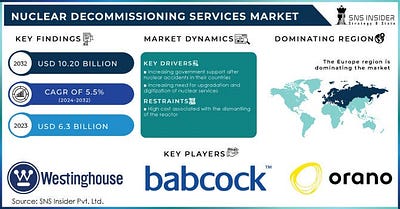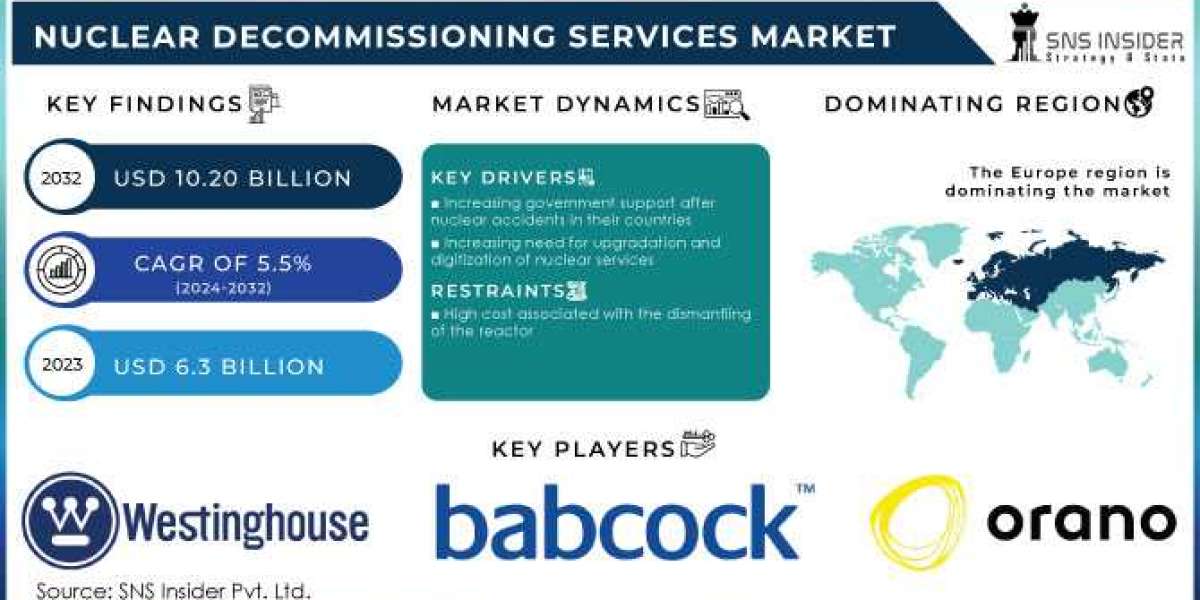
The Nuclear Decommissioning Services Market size was valued at USD 6.3 billion in 2023 and is expected to grow to USD 10.20 billion by 2032 and grow at a CAGR of 5.5% over the forecast period of 2024–2032.
Nuclear decommissioning is the process of safely retiring nuclear facilities from service, which involves decontaminating and dismantling structures, removing spent nuclear fuel, managing radioactive materials, and restoring the environment to prevent any harmful radiation exposure. The market for decommissioning services is expected to rise significantly as many nuclear reactors worldwide approach the end of their service life, particularly in Europe, North America, and parts of Asia-Pacific.
Market Overview
The Nuclear Decommissioning Services Market encompasses a broad range of services, including site investigation, decontamination, dismantling of structures, waste management, and environmental remediation. These services ensure that nuclear facilities are safely taken offline, radioactive materials are properly disposed of, and environmental risks are minimized.
Nuclear decommissioning is a complex and highly regulated process that requires specialized expertise, sophisticated technology, and stringent safety protocols. The demand for decommissioning services is rising as governments and operators seek to ensure that decommissioned sites meet strict regulatory standards and pose no threat to public health or the environment.
Key Market Drivers
- Aging Nuclear Reactors: Many nuclear power plants that were constructed in the 1960s, 1970s, and 1980s are now reaching the end of their operational lifetimes. This has led to a surge in demand for decommissioning services as reactors are shut down and decommissioned in accordance with regulatory requirements.
- Government Regulations and Safety Standards: Governments worldwide have enacted stringent regulations governing the safe decommissioning of nuclear facilities. These regulations ensure that decommissioning processes are carried out with the highest safety and environmental standards, which is driving the need for specialized decommissioning services.
- Increased Focus on Environmental Remediation: As public awareness of environmental and health risks associated with radioactive waste grows, there is increasing pressure on governments and nuclear operators to prioritize environmental remediation during the decommissioning process. This includes safely managing radioactive waste and restoring decommissioned sites to their original or usable condition.
- Shift Toward Renewable Energy: The global transition toward renewable energy sources, such as wind, solar, and hydropower, is leading to the gradual decline of nuclear power in many countries. As a result, more nuclear facilities are being decommissioned, creating significant opportunities in the nuclear decommissioning services market.
- Technological Advancements in Decommissioning: Advancements in robotics, artificial intelligence (AI), and remote-controlled machinery are making decommissioning processes more efficient and safer. These technologies are helping to reduce the risks associated with dismantling radioactive structures and handling hazardous materials.
Market Segmentation
The Nuclear Decommissioning Services Market is segmented by service type, reactor type, strategy, and region.
By Service Type
- Decontamination and Decommissioning (DD): This involves cleaning and dismantling radioactive equipment, buildings, and systems to reduce radiation levels and safely remove hazardous materials.
- Waste Management: The handling, processing, and disposal of radioactive waste generated during the decommissioning process. This includes managing spent nuclear fuel and other high-level waste.
- Site Remediation: Restoring the environment and surrounding areas to a safe condition by removing residual contamination and hazardous materials after the facility has been dismantled.
- Others: Includes consulting, regulatory compliance services, and project management for complex decommissioning projects.
By Reactor Type
- Pressurized Water Reactor (PWR): The most common type of reactor in the world, used extensively in commercial nuclear power plants.
- Boiling Water Reactor (BWR): Another common reactor type, used in nuclear power generation, with decommissioning needs as plants reach the end of their lifecycle.
- Gas-Cooled Reactor (GCR): Used in select nuclear plants, primarily in the UK and Europe, these reactors have unique decommissioning challenges due to their design.
- Others: Includes smaller research reactors and experimental reactors, which also require decommissioning as they age.
By Strategy
- Immediate Dismantling (DECON): Involves promptly dismantling the facility and removing radioactive materials after the reactor is shut down, allowing for a quicker return of the site to normal use.
- Safe Enclosure (SAFSTOR): A delayed decommissioning strategy where the plant is maintained in a safe condition for several decades before final dismantling takes place. This approach allows radiation levels to decrease naturally, reducing the risk to workers.
- Entombment: A less common strategy where radioactive materials are permanently sealed within the facility, often covered with concrete, to prevent radiation from escaping. This method is typically used for smaller facilities or when dismantling poses significant risks.
Regional Analysis
- Europe: Europe is the largest market for nuclear decommissioning services, with countries like Germany, France, and the United Kingdom leading the way. Germany’s decision to phase out nuclear energy by 2022, coupled with the aging nuclear fleet in France, has created significant demand for decommissioning services in the region. The European Union’s stringent regulations on nuclear safety and waste management also contribute to the market’s growth.
- North America: The United States and Canada are key markets in North America, with several nuclear plants nearing decommissioning. The U.S. Nuclear Regulatory Commission (NRC) and Canadian Nuclear Safety Commission (CNSC) have established comprehensive decommissioning regulations that are driving demand for specialized services.
- Asia-Pacific: In the Asia-Pacific region, countries like Japan and South Korea are ramping up their decommissioning efforts following nuclear shutdowns. Japan’s response to the Fukushima Daiichi disaster has accelerated the decommissioning of older reactors, with a growing focus on safety and environmental impact.
- Middle East Africa: While nuclear energy is less prominent in this region, some countries are beginning to explore nuclear decommissioning services as they plan the eventual shutdown of facilities or decommission research reactors.
- Latin America: Brazil and Argentina have operational nuclear reactors, with future decommissioning projects expected as these plants age. As Latin American nations explore the long-term management of nuclear power, demand for decommissioning services will increase.
Current Market Trends
- Collaborative Projects: Governments and private sector players are increasingly collaborating to manage large-scale decommissioning projects. Public-private partnerships are common, allowing for more efficient and cost-effective decommissioning solutions.
- Focus on Cost Reduction: The high cost of decommissioning has led to a focus on cost-saving innovations, including the use of new technologies and optimized project management strategies to reduce overall project expenses.
- Growth in Waste Management Solutions: As decommissioning projects generate significant amounts of radioactive waste, the demand for advanced waste management technologies and services is growing. This includes the development of long-term storage solutions for spent nuclear fuel and high-level radioactive waste.
Read Complete Report Details of Nuclear Decommissioning Services Market 2024–2032@ https://www.snsinsider.com/reports/nuclear-decommissioning-services-market-2723
About Us:
SNS Insider is a global leader in market research and consulting, shaping the future of the industry. Our mission is to empower clients with the insights they need to thrive in dynamic environments. Utilizing advanced methodologies such as surveys, video interviews, and focus groups, we provide up-to-date, accurate market intelligence and consumer insights, ensuring you make confident, informed decisions.
Contact Us:
Akash Anand — Head of Business Development Strategy
info@snsinsider.com
Phone: +1–415–230–0044 (US) | +91–7798602273 (IND)














